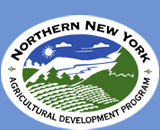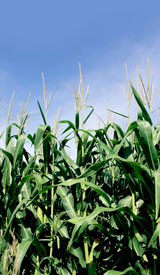July 30, 2007
Contact: Sally A. Flis, or Everett D. Thomas, Miner Institute,
518-846-7121 x126, 115
Survey Results Measure Copper on Northeast Dairy Farms;
NNY Research Trials Evaluate Effects on Grass and Corn Crops
As part of dairy industry research funded by the Northern New York
Agricultural Development Program, a survey is underway to determine the
current average application rates of copper on Northeast farms. The use
of copper sulfate in footbaths to prevent hoof ailments in dairy cows
can affect crop yield, forage content, and how quickly a field reaches
its regulated limit for copper load. The New York State Department of
Environmental Conservation has set a lifetime field load limit for
copper at 74 lbs/acre.
Sixty-one (61) New York farms have responded to a survey sent to dairies
in NY, Vermont, New Hampshire, Maine, Massachusetts and Pennsylvania.
University of Vermont Ph.D. graduate student Sally A. Flis working with
the William H. Miner Agricultural Research Institute in Chazy, NY, has
been researching how the copper in the discarded footbath solution
applied with manure affects grass and corn crops. She has conducted
three studies to establish baseline and tracking data for the use of the
copper sulfate solutions in the region.
Copper sulfate is twenty-five percent (25%) copper by weight. A 2001
survey that showed an average of 2.14 lbs/acre of copper was imported
onto farms in Vermont and New York at that time. A survey in 2004 showed
an average import of about 1.37 lbs of copper per acre. The 2007 survey
showed that the equivalent of an average import of 2.1 pounds of copper
per acre. Crops remove on average 0.09 lbs of copper per acre per year.
The application rates calculated for the earlier surveys were based on
total acres; the 2007 survey used a calculated number of acres based on
total tillable acres and the percent receiving manure that was reported
by the producer.
Flis says the average for the 2007 survey represents a much larger
number of farms surveyed across the multi-state area and the application
rates for the three survey years do not represent a trend.
The 2007 survey results also show:
� seventy-three percent (73%) of the farms returning surveys use
footbaths
� the average size of farms using the footbaths was 433 lactating cows
� the average size of the farms not using footbaths was 63 lactacting
cows
� copper sulfate was the solution used by eighty-three percent (83%) of
the farms using footbaths
� eighty-eight percent (88%) of the farms using footbaths discarded used
solution intomanure storages.
� twenty-four percent (24%) of all farms responding use copper footbaths
with all their animals
� half of the farms used the footbaths only for lactacting cows.
Grass Crops May Be More Affected than Corn
Earlier this year, the Northern New York Agricultural Development
Program and Miner Institute issued the results of research on how the
copper in discarded footbaths that is applied with manure and
accumulates in the soil affects grass and corn crops. That research
shows:
� copper toxicity affects plant roots first
� concentrations in the roots of timothy and orchardgrass grown on sandy
loam soil at Miner Institute showed that as copper concentrations in
manure applications increased, the desired regrowth of shoots (tillering
rate) and the dry weight of shoots and roots decreased.
� copper levels in the shoots of the timothy and orchardgrass crops
increased but were within normal range for concentration of the mineral
in the plants (0-50 ppm).
� an increased copper load can cause orchardgrass and timothy crops to
suffer a grass shoot weight loss equivalent to 339 lbs of productions
per acre (greenhouse studies).
�The results of this research cause concern about how continued disposal
of copper sulfate footbaths into manure systems will decrease the
longevity and yield of the grass stands,� says Everett D. Thomas,
vice-president of agricultural programs at the William H. Miner
Agricultural Research Institute. �There may also be concern for a larger
decrease in these perennial grasses� regrowth rate and yield loss in
drought conditions.�
Flis says a one-year application totaling less than 17 lbs/acre of
copper from dairy manure applied at a rate of 4,900 gallons per acre
does not appear to negatively affect the growth, yield or plant copper
in corn crops, but �continued research is needed on how multiple high
application rates of copper sulfate affect corn since a single
application of dairy manure to corn is not a common practice.�
Grass & Corn Research and Analysis Continues in 2007
The research at Miner Institute on copper sulfate�s effect on grass and
corn crops continues in 2007. Trials with reed canary grass and with all
three grasses - reed canary grass, timothy and orchardgrass - on silt
loam soil in 2006 experienced difficulties. The reed canary grass died
after the first cut; the silt loam soil trials did not germinate well.
Those trials are being rerun this year along with trials evaluating the
copper sulfate�s affect on alfalfa and corn crops.
Miner Institute has reduced its use of copper sulfate footbaths with its
dairy herd by sixty percent by employing diligent hoof trimming
practices and rubber mats to manage cow hoof health.
Data from the 2007 footbaths survey is still being analyzed and a
complete report is expected later this year. A summary of 2007 research
will be posted on the Northern New York Agricultural Development Program
website at www.nnyagdev.org.
The Northern New York Agricultural Development Program is a farmer-led
program that funds on-farm research, education and outreach for Clinton,
Essex, Franklin, Jefferson, Lewis and St. Lawrence counties. The Program
goals include strengthening production practices and profitability for
all types of agricultural businesses in the region. To learn more about
the copper footbaths research and other projects on NNY farms, go online
to www.nnyagdev.org.



